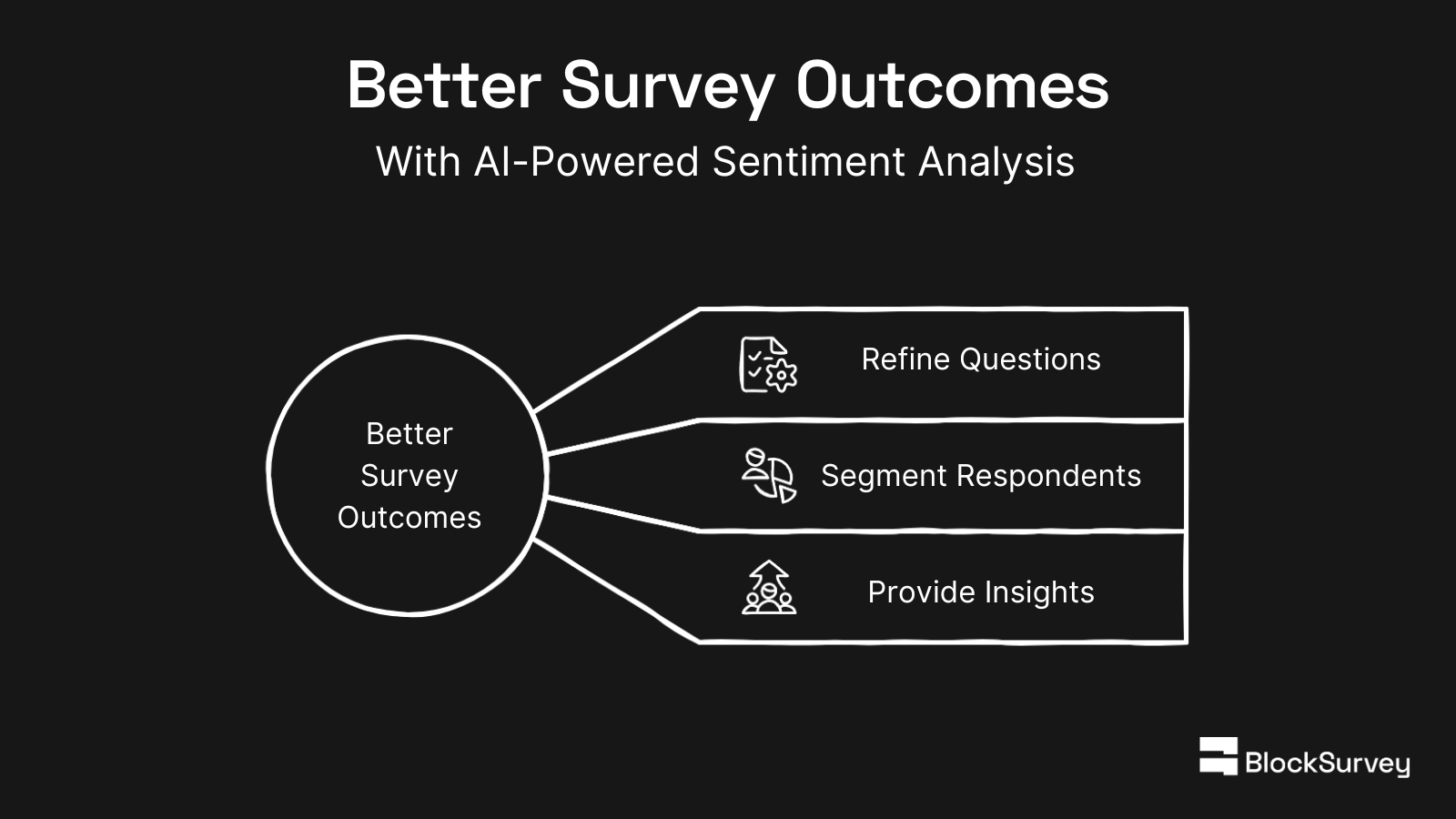Get insights.
Unlock value.
- 14-day free trial
- Set up in minutes
- No credit card required
From Data to Decisions: Using AI Sentiment Analysis to Improve Survey Outcomes
You've just collected hundreds of survey responses, but as a qualitative researcher, you know that manually analyzing sentiments can feel like searching for a needle in a haystack. What if there was a way to streamline this process and uncover insights faster than ever?
Manual sentiment analysis is time-consuming. It is painful to analyze the sentiments of large datasets. In addition, the manual method is prone to human bias. It is for these painful reasons a researcher can exercise the use of AI-powered tools for sentiment analysis.
More about AI-powered sentiment analysis will be discussed in the next section.
What is AI sentiment analysis?
It is the AI-assisted method of performing sentiment analysis. AI sentiment analysis uses Natural Language Processing & Machine Learning to determine the polarity. It uses Rule-based sentiment scoring by comparing responses with a library of keywords. The sentiment polarity can be positive, negative, or neutral. AI helps you determine emotional tone with clarity & speed. BlockSurvey provides built-in AI sentiment analysis of your survey responses.
Remember, AI-powered sentiment analysis is fast, accurate & scalable.
How does AI Sentiment analysis improve survey outcomes?

Helps refine your survey questions
One can identify current trends in responses with the help of sentiment analysis. Survey questions can be refined in accordance with the identified trends, leading to better quality of surveys. This also helps to connect easily with the respondents.
Helps segment your respondents
Group and segment your respondents as per the sentiment polarity of their respondents. Each of positive, negative, and neutral sentiment can be grouped together. The respondent group can be later used for targeted survey follow-ups.
Helps take insightful solution
Start leveraging on the insights received from respondents’ response polarity & shape improvement accordingly. For example, you can address the negative sentiment areas, by providing a quick resolution. In this way, you can improve the process.
AI Sentiment Analysis: Example Surveys
You can find below three example surveys with a sample survey question, followed by sample answers belonging to each sentiment polarity (positive, negative & neutral).
Customer Feedback Survey
Survey Question:
How satisfied are you with the overall experience of using our product?
Answers:
- Positive: "I'm very satisfied; the product exceeded my expectations!"
- Neutral: "It's okay; it works as expected but nothing extraordinary."
- Negative: "I'm dissatisfied; the product did not meet my needs."
Employee Engagement Survey
Survey Question:
How would you rate your overall engagement and satisfaction at work?
Answers:
- Positive: "I'm highly engaged and feel valued at work."
- Neutral: "I feel moderately engaged, but there's room for improvement."
- Negative: "I'm not engaged and often feel unmotivated.”
Product Review Survey
Survey Question:
How would you rate the usability of our product?
Answers:
- Positive: "The product is extremely user-friendly and intuitive!"
- Neutral: "The product is usable, but it could be easier to navigate."
- Negative: "The product is difficult to use and frustrating."
How BlockSurvey can help?
BlockSurvey provides you with a built-in AI sentiment analysis feature. BlockSurvey uses Rule-based sentiment scoring (responses are compared with a library of keywords) to determine the sentiment polarity (positive, negative, or neutral) of the survey responses.
BlockSurvey can help in the following ways when it comes to AI sentiment analysis.
- It provides you with an Overall Sentiment Score by aggregating the sentiments of all individual responses.
- It provides a sleek graphic design to depict the Overall sentiment score of the responses.
- It helps get the total count of positive, negative, or neutral sentiments of individual responses.
- It provides an option to export your response along with the identified sentiment.
Worried about data protection during AI sentiment analysis? Read on.
How BlockSurvey protect your data?
Anonymous usage: BlockSurvey’s AI-powered sentiment analysis prioritizes privacy by avoiding direct data submission to LLM. Instead, it sends minimal mapped data to LLM to find context. This approach ensures anonymity while determining sentiment polarity. Your data is never used for training.
End-to-end encrypted: BlockSurvey prioritizes privacy by encrypting all data, ensuring that only the data owner can have access. This privacy-first approach eliminates the risk of unauthorized access, providing complete and secure ownership of data.
No third-party trackers or analytics: BlockSurvey ensures complete privacy by not running any third-party analytics, meaning no external entities can track or collect your or your audience’s data. This guarantees that all data remains secure and confidential within the platform.
Data to decisions made easy
In today’s data-driven world, transforming raw survey responses into actionable insights is no longer a luxury—it's a necessity. By leveraging AI-powered sentiment analysis, the process of analyzing sentiments becomes faster, more accurate, and infinitely scalable. No more struggling with manual, time-consuming, and error-prone methods.
BlockSurvey empowers you to effortlessly unlock the emotional tone behind your survey data, refine your approach based on trends, and segment respondents for tailored follow-ups.
With privacy at its core, BlockSurvey ensures your data remains secure and confidential, giving you complete control and peace of mind.
BlockSurvey's AI-driven sentiment analysis helps you bridge the gap between data collection and decision-making.
Make your insights work for you—easily, efficiently, and securely.
From Data to Decisions: Using AI Sentiment Analysis to Improve Survey Outcomes FAQ
Can AI sentiment analysis be used for other languages besides English?
Yes, AI sentiment analysis can be used for languages other than English. However, the accuracy of the analysis may vary depending on the language and the availability of training data for that language.
What are the limitations of AI sentiment analysis?
AI sentiment analysis may struggle with sarcasm, irony, and complex language constructs. It may also be biased toward the data it was trained on.
How does BlockSurvey’s rule-based sentiment scoring ensure accuracy?
BlockSurvey uses a library of keywords and phrases that are associated with positive, negative, and neutral sentiment. The system then compares the responses to this library to determine the overall sentiment.
Get insights.
Unlock value.
- 14-day free trial
- Set up in minutes
- No credit card required

